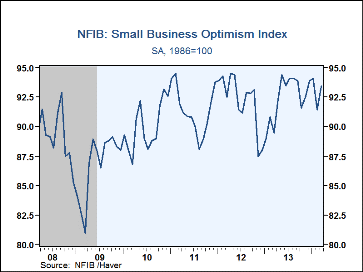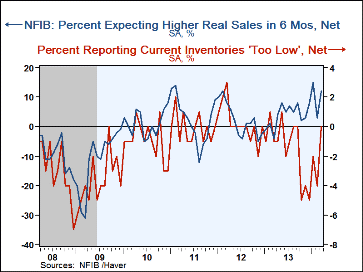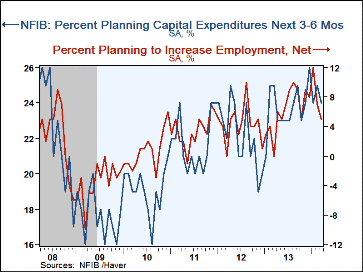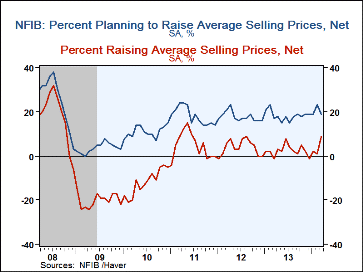 Global| Apr 08 2014
Global| Apr 08 2014U.S. Small Businesses Optimism Is Driven Higher by Improved Sales Expectations and Low Inventories
by:Tom Moeller
|in:Economy in Brief
Summary
The National Federation of Independent Business reported that its Small Business Optimism Index recovered to 93.4 during March and made up most of its February decline to 91.4. Despite the latest increase, small business optimism did [...]
The National Federation of Independent Business reported that its Small Business Optimism Index recovered to 93.4 during March and made up most of its February decline to 91.4. Despite the latest increase, small business optimism did not beak away from the sideways trend of the last nine months.
A recovery in sales expectations during the next six months provided the lift to last month's overall index. Inventories were reported as too low by a greatly increased number of firms and a few more businesses expected higher sales in six months. The percentage of firms indicating that now was a good time to expand the business recovered February's decline. Offsetting these gains was a sharp decline in the number of firms planning to raise employment and a lessened number looking to raise capital expenditures. The percentage of firms with positions they were not able to fill right now has been moving roughly sideways for the last six months. The percentage looking to raise capital expenditures also has been trending sideways for most of the last year.
A reduced 19% of firms planned to raise average selling prices, and the figure has trended sideways for a year. An increased 9% of firms were raising them now, the most since August 2012. A stable 14% planned to increase worker compensation, the most of the economic recovery.
The most important problems faced by small business were government requirements (21%), taxes (21%), poor sales (14%), insurance cost & availability (10%), quality of labor (9%), competition from large businesses (8%), cost of labor (5%), inflation (3%) and financial & interest rates (2%).
Roughly 24 million small businesses exist in the U.S. and they create 80% of all new jobs. The typical NFIB member employs 10 people and reports gross sales of about $500,000 a year. The NFIB figures can be found in Haver's SURVEYS database.
| National Federation of Independent Business | Mar | Feb | Jan | Mar'13 | 2013 | 2012 | 2011 |
|---|---|---|---|---|---|---|---|
| Small Business Optimism Index (SA, 1986=100) | 93.4 | 91.4 | 94.1 | 89.5 | 92.4 | 92.2 | 91.4 |
| Firms Expecting Higher Real Sales In Six Months (Net %) | 12 | 3 | 15 | -4 | 4 | 2 | 3 |
| Firms Expecting Economy To Improve (Net %) | -18 | -19 | -11 | -28 | -15 | -9 | -9 |
| Firms Planning to Increase Employment (Net %) | 5 | 7 | 12 | 0 | 6 | 4 | 3 |
| Firms With Few or No Qualified Applicants For Job Openings (Net %) | 41 | 40 | 38 | 36 | 39 | 35 | 32 |
| Firms Reporting That Credit Was Harder To Get (Net %) | 8 | 8 | 6 | 4 | 6 | 8 | 10 |
| Firms Raising Average Selling Prices (Net %) | 9 | 1 | 2 | -1 | 2 | 4 | 5 |
Tom Moeller
AuthorMore in Author Profile »Prior to joining Haver Analytics in 2000, Mr. Moeller worked as the Economist at Chancellor Capital Management from 1985 to 1999. There, he developed comprehensive economic forecasts and interpreted economic data for equity and fixed income portfolio managers. Also at Chancellor, Mr. Moeller worked as an equity analyst and was responsible for researching and rating companies in the economically sensitive automobile and housing industries for investment in Chancellor’s equity portfolio. Prior to joining Chancellor, Mr. Moeller was an Economist at Citibank from 1979 to 1984. He also analyzed pricing behavior in the metals industry for the Council on Wage and Price Stability in Washington, D.C. In 1999, Mr. Moeller received the award for most accurate forecast from the Forecasters' Club of New York. From 1990 to 1992 he was President of the New York Association for Business Economists. Mr. Moeller earned an M.B.A. in Finance from Fordham University, where he graduated in 1987. He holds a Bachelor of Arts in Economics from George Washington University.










